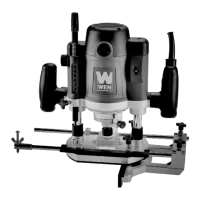GENERAL SAFETY RULES
POWER TOOL OPERATION
1. Avoid accidental start-ups. Make sure the power switch is in the OFF position before connecting the plug to a
power source or carrying the tool.
2. Check power tool for damaged parts. Check for misalignment of moving parts, jamming, breakage, improper
mounting, or any other conditions that may affect the tool’s operation. Any part that is damaged should be properly
repaired or replaced before use.
3. Do not force the tool to do a job for which it was not designed. Use correct accessories and follow the instructions
for your application to prevent hazardous situations.
4. Remove adjustment tools. Always make sure all adjustment tools or wrenches are removed from the tool before
turning on the power tool.
5. Keep guards in place and in working order before operating the tool. All protection and safety devices must be
replaced after completing repair and maintenance procedures.
6. Never leave a running tool unattended. Do not leave the tool until it has come to a complete stop.
7. Always disconnect the power cord plug from the electrical outlet when making adjustments, changing parts, or
storing power tools in order to reduce the risk of accidentally starting the power tool.
8. Maintain power tools properly. Safely store power tools out of the reach of children. Always keep tools clean and
in good working order. Follow instructions for cleaning and changing accessories.
9. Only have your power tool serviced by a qualified repair person using only identical replacement parts. Use of
any other part can cause personal injury and damage to the tool.
4
WARNING: Substantial or repeated inhalation of dust and other airborne contaminants, in particular
those with a smaller particle size, may cause respiratory or other illnesses.
Various dusts created by power sanding, sawing, grinding, drilling and other construction activities contain chemi-
cals or substances known (to the State of California and others) to cause cancer, birth defects or other reproductive
harm. Some examples of these chemicals/substances are:
• lead from lead-based paints;
• crystalline silica from bricks, cement, and other masonry products;
• arsenic and chromium from chemically-treated lumber; and
• some wood dusts, especially from hardwoods, but also from some softwoods such as Western Red Cedar.
Your risk from these exposures varies, depending on how often you do this type of work. To reduce your expo-
sure to these chemicals: work in a well ventilated area use a properly functioning dust extraction system. Wear
dust masks that are specially designed to filter out microscopic particles.

